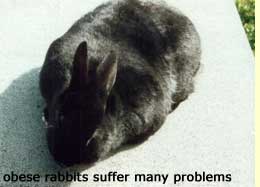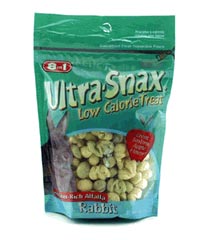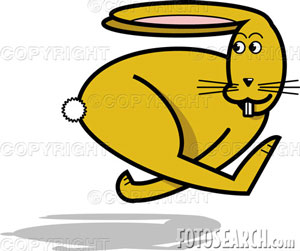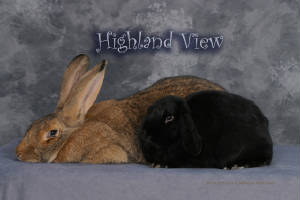|
The domestic rabbit is very prone to obesity. Wild rabbits often have miles of territory in which the travel across
to forage, whereas pet rabbits are often caged in 2 ft by 2 ft cages. Obesity, or the collection of body fat, is the most
common nutritional disease in all pets.
A rabbit is obese when he weighs 15 percent more than his optimal body weight. (Your veterinarian can determine your
pet's optimal weight.) The rule of thumb: You shouldn't clearly see your pet's ribs, but you should feel them under a slight
covering of fat. (www.petco.com).
Obesity is a very serious issue in rabbits because of the health problems it can cause. When the
musculoskeletal system bears excessive weight day in and day out, joint and locomotion problems can develop, including arthritis
or spinal injury. Obese rabbits may stop grooming, especially the area around the anus and the scent glands, and they may
experience chronic, intermittent diarrhea. Obesity also leads to respiratory and heart disease, high blood pressure, fertility
problems, liver abnormalities, skin problems and even cancer. The bottom line: Obesity shortens the duration and quality of
your pet's life. (www.petco.com).

Determining Obesity
Ideally, you should weigh your rabbit every month to watch for any weight changes. A steady
weight gain usually points to a needed change of diet, while sudden weight gain points to an illness. Besides weighing your
rabbit, a physical exam can be performed to evaluate weight. “Rabbits store fat inside their abdomen, which makes just
eyeballing them for love handles ineffective. Run your hands along your rabbit's side, feeling the rib cage. When you reach
the end of the ribs, you should be able to feel a slight inward slope, the waist. Fat bunnies will balloon out instead.”
(Kruse). The size of the dewlap under a rabbit’s chin, or the skirt, a fold of skin near the base of the tail, can also
be used to determine obesity, but should not be used solely as many ideal weight rabbits have large skirts and dewlaps.

Cause
of Obesity: Not Just Overeating!
There
are many causes for obesity in rabbits, the major cause is overeating. “This condition again usually results when an
animal is being fed too many pellets. Rabbit pellets are high in calories and low in fiber.” (Finch). According to Hill’s
Pet Nutrition, many pet rabbit owners use treats and food for affection, especially If the rabbit owner does not feel they
spend enough time with their rabbit. Many commercially produced rabbit treats are very high in fat and many pet owners give
their rabbits too many of these treats. Disease and other medical disorders can also cause weight gain. Neutering and spaying
increases the risk of weight gain. Pets that do not get enough exercise are more likely to gain weight and may need fewer
calories when they have decreased activity. Increased age in older pets can also cause weight gain, older pets are often less
active, requiring fewer calories, but many owners do not decrease their caloric intake.

Treatment
The
hardest part in treating obese rabbits is admitting that the rabbit is obese. Many pet owners feel very guilty about letting
their pet’s health go. The only effective obesity treatment is to decrease fat and food intake, and increase activity.
The latter can be very difficult as many rabbits have other health problems that limit their ability to exercise. Often times
a simple change in diet can cause weight loss. Rabbits should be fed a diet of pellets with a high percentage of fiber, low
percentage of protein, and very low percentage of fat. The rule of thumb is ¼ a cup of pellets for every 5 pounds of rabbit
body weight. The rabbit should also be fed an unlimited amount of straws and hays. These high fiber plants aid in digestion
and “fill” the rabbit up with low fat, healthy food. Vegetables and
treats can still be given, however, starchy vegetables like carrots should be cut out, and fruits should also be cut out because
of the amount of sugar content. Vegetables should consist of an assortment of bitter leaves and other plants. An overweight
rabbit should be fed twice a day using the ¼ a cup of pellets a day for every five pounds of weight, limited greens, and unlimited
hays/straws. All treats should be cut out of the diet. “If you are overfeeding, slowly reduce the volume of food to
the proper intake level.” (www.petco.com).
Exercise is often the hardest part of the
diet, but the most crucial, the diet change only prevents more fat from being added on, so the rabbit needs to work off the
fat built up in the body. If the rabbit is caged for most of the day, or lives in the house but doesn’t move much, simply
taking the rabbit to an enclosed large pen outside will cause the rabbit to become active. Being outside and in the grass
will generally be enough of a motivation for the rabbit to get up and investigate its surroundings, and even run and play.
If the rabbit is incapable of exercise due to other health problems, the owner needs to consult with their vet for further
information on weight loss diets.
Often times it is not possible
to take the rabbit outside. If the rabbit is caged, allowing the rabbit outside of the cage to play in a bunny proof room
is an option. If the rabbit is a low activity rabbit, toys can be used to get the rabbit moving. The best toys mentally stimulate
a rabbit. Toys that the rabbit has to work on getting treats out of can really get a rabbit moving. In the case of an obese
rabbit, the treats can be food like straw or bitter greens.
Weight loss in rabbits
does not happen over night. According to Weight Watching for Rabbits; the key to diet change and weight loss is to do it gradually.
Any fast weight loss will risk doing major, sometimes fatal, damage to the liver as it becomes clogged with fat. However, the sooner the rabbit looses weight, the better.
If
you think you are doing everything correctly, and your rabbit is still obese, your veterinarian may need to evaluate him for
possible medical causes, such as low metabolic rate, hypothyroidism or diabetes. (www.petco.com)
Healthy weight rabbits live happier, healthier, and longer lives.

Prevention: The Best Way to Fight Obesity
Preventing obesity in rabbits is much easier than treating obesity. Rabbits should be fed ¼ a cup of pellets
per five pounds of body fat, and unlimited straw with a fair amount of bitter greens. Treats should be fed occasionally, and
the treats should be low in fat.
To discourage overeating and prevent obesity in the future, remove the food bowl one hour after serving. Encourage
your rabbit to get exercise by taking him out of his cage and letting him run around for a while under well-supervised conditions.
(www.petco.com).
If the rabbit is purebred and the breed is recognized by the American Rabbit
Breeders Association, then the breed has a maximum and minimum weight. The weight varies with each breed, so it is important
to find out what the ideal weight is for your rabbit. Keeping an eye out for your rabbit’s weight is very crucial, especially
in aging rabbits, as they become less active.

When a
rabbit owner can recognize, treat, and prevent obesity, they can help their rabbit live a long and healthy life. Monthly weight
checks and physical exams can aid the pet rabbit owner in determining the weight status of their bunny. Overeating is the
number one cause of obesity in rabbits. Disease or other health problems can also cause an increase in weight. Rabbits that
are confined to small environments, or are older or less active will also have increase weight gain. The best treatment
for obesity in rabbits is a gradual decrease of food and an increase in activity. However, the hardest part of the
diet is getting the rabbit moving. Treats and other fatty foods should be cut off from the diet, and for inactive rabbits,
toys that mentally stimulate the rabbit, and going outside to run around will often motivate the rabbit to move. If the owner
does not see a weight loss, the vet should be consulted. Helping that furry friend lose weight can be the best thing an owner
can do for their pet. Not only will the rabbit look like a slim and sleek, and be fit, but they'll feel great and hopefully
be snuggling for years to come.
Works Cited
Finch, DVM, Nickol. "Is your Bunny Healthy?." College of Veterinary Medicine.
17 July 2004. Washington State
University. 16 Nov. 2005 <http://www.vetmed.wsu.edu/>.
Hrapkiewicz DVM, MS, Karen, Leticia Medina
DVM, and Donald D. Holmes DVM, MS. Clinical Laboratory Animal Medicine an Introduction. 2nd ed. Ames:
Blackwell, 1998.
Kruse, DVM, Astrid M. "Weight Watching for Rabbits." House Rabbit Network. House Rabbit Network. 16 Nov. 2005 <http://www.rabbitnetwork.org/>.
"Obesity in Rabbits." petco.com. Petco. 18 Nov. 2005
<http://www.petco.com/>.
Weight Management: Caring for your Pet. n.p.: Hill's Pet Nutrition
Inc., 2005.
Copywrite 2005. All Rights reserved. Article to be used with writer's permission.
|

